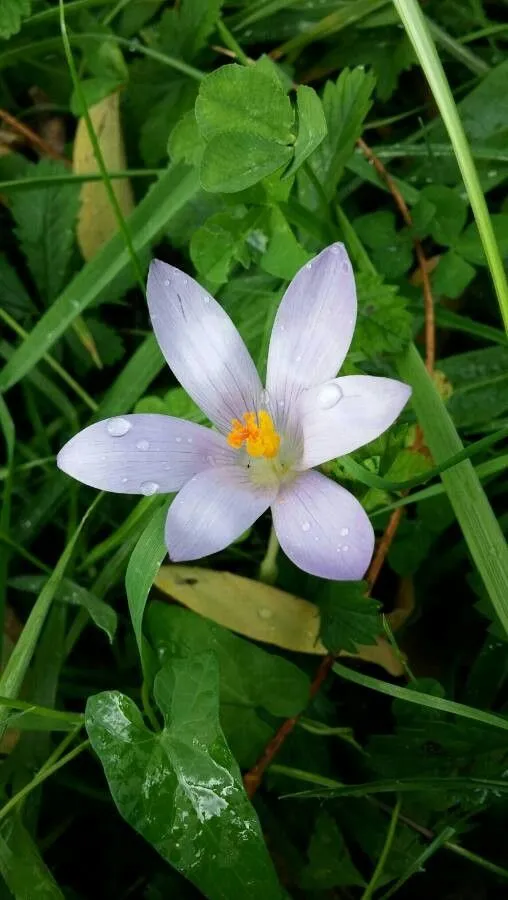
Author: Sm.
Bibliography: Engl. Bot.: t. 491 (1798)
Year: 1798
Status: accepted
Rank: species
Genus: Crocus
Vegetable: Unknown
Observations: SW. France to N. Spain
The Knights of St. John Crocus, scientifically known as Crocus nudiflorus, is a captivating flowering plant native to the southwestern regions of France and extending into northern Spain. This delicate plant is a member of the Iridaceae family, renowned for its vibrant and colorful species that often herald the arrival of spring.
Crocus nudiflorus is distinguished by its striking blossoms that emerge directly from the corms, often before the leaves appear, creating an enchanting display of color. The flowers are typically a beautiful blend of purples, with a hint of violet or lilac, and feature a soft, delicate texture that adds to their allure. The petals are slender and elongated, giving the flowers a graceful, almost ethereal appearance.
This species was first described in 1798, as documented in the English Botany (Engl. Bot.: t. 491) by the esteemed botanist James Edward Smith, commonly referenced simply as “Sm.” This early documentation has allowed botanists and plant enthusiasts to trace its history and cultivation practices.
In its natural habitat, the Knights of St. John Crocus thrives in meadows and open woodland areas, where it benefits from the well-drained soils and moderate climates characteristic of its native regions. The plant’s ability to bloom in fall or early winter, when many other plants have ceased flowering, adds to its value as a garden specimen and a subject of botanical interest.
Cultivating Crocus nudiflorus in gardens outside its native range offers a unique opportunity to enhance late-season floral displays. Gardeners aiming to grow this species should emulate its natural conditions by ensuring plenty of sunlight, good drainage, and protection from severe frosts. When planted in groups, the flowers create a stunning carpet of color that can transform garden spaces.
In summary, the Knights of St. John Crocus (Crocus nudiflorus) is a remarkable plant cherished for its vibrant fall blooms and graceful appearance. Its historical documentation and natural charm make it a valuable addition to both botanical collections and home gardens, keeping the legacy of this exquisite species alive for future generations to appreciate.
Eng: autumn crocus
Swe: krypkrokus
Cym: saffrwm noeth-flodeuog, saffrwm y gweunydd, saffrwm yr hydref
En: Knights of St John Crocus, Naked-flowering crocus, Autumn Crocus
Eu: Azafrai zangar
Ca: Safrà bord, Safrà bord pirinenc
Fr: Crocus à fleurs nues, Crocus d’automne
De: Pyrenäen-Herbst-Krokus
Is: Vínkrókus
Sv: Krypkrokus
Cy: Saffrwm yr hydref, Saffrwm Noeth-Flodeuog, Saffrwm y Gweunydd
© copyright of the Board of Trustees of the Royal Botanic Gardens, Kew.
© copyright of the Board of Trustees of the Royal Botanic Gardens, Kew.
© copyright of the Board of Trustees of the Royal Botanic Gardens, Kew.
Taken Apr 17, 2018 by Guilhem Espert (cc-by-sa)
Taken Sep 17, 2018 by biardeau (cc-by-sa)
Taken Jan 30, 2020 by Santonicola Gerardo (cc-by-sa)
Taken Mar 13, 2018 by Fejul Xeto (cc-by-sa)
Taken Nov 3, 2017 by Susana López (cc-by-sa)
Taken Oct 11, 2020 by Clapés Jordi (cc-by-sa)
Taken Oct 15, 2022 by Pierre (cc-by-sa)
Taken Oct 13, 2019 by Jean-Christophe Lombardo (cc-by-sa)
Taken Feb 17, 2022 by Emmanuel BOUCHARD (cc-by-sa)
Taken Mar 11, 2022 by Gianni Franchi (cc-by-sa)
Taken Feb 8, 2022 by David Hocken (cc-by-sa)
Taken Sep 26, 2013 by Tela Botanica − Alain BIGOU (cc-by-sa)
Taken Oct 12, 2022 by Lorand Penzes (cc-by-sa)
Taken Mar 2, 2022 by Radish Rabano (cc-by-sa)
Taken Oct 27, 2022 by Bodoba Marie (cc-by-sa)
Taken Oct 5, 2017 by Jose Luis Romero (cc-by-sa)
Taken Oct 2, 2022 by Océane Cancela (cc-by-sa)
Taken Oct 11, 2020 by Clapés Jordi (cc-by-sa)
Taken Oct 15, 2007 by Photoflora – Jean-Luc TASSET (©)
Taken Jan 1, 1970 by Photoflora – L’Abbé COSTE (©)
Taken Jun 2, 2022 by Resquicio Julián (cc-by-sa)
Taken Mar 11, 2022 by Gianni Franchi (cc-by-sa)
Taken Jun 2, 2022 by Resquicio Julián (cc-by-sa)
Taken Sep 17, 2022 by Julien Champ (cc-by-sa)
Family: Myrtaceae Author: (F.Muell.) K.D.Hill & L.A.S.Johnson Bibliography: Telopea 6: 402 (1995) Year: 1995 Status:…
Family: Rubiaceae Author: Pierre ex A.Froehner Bibliography: Notizbl. Bot. Gart. Berlin-Dahlem 1: 237 (1897) Year:…
Family: Sapindaceae Author: Koidz. Bibliography: J. Coll. Sci. Imp. Univ. Tokyo 32(1): 38 (1911) Year:…
Family: Asteraceae Author: A.Gray Bibliography: Pacif. Railr. Rep.: 107 (1857) Year: 1857 Status: accepted Rank:…
Family: Fabaceae Author: Medik. Bibliography: Vorles. Churpfälz. Phys.-Ökon. Ges. 2: 398 (1787) Year: 1787 Status:…
Family: Aspleniaceae Author: (Cav.) Alston Bibliography: Bull. Misc. Inform. Kew 1932: 309 (1932) Year: 1932…